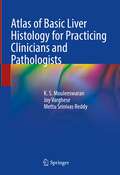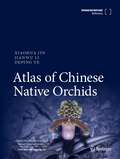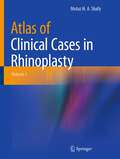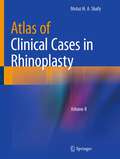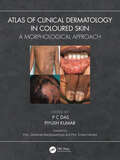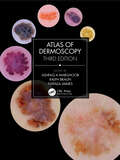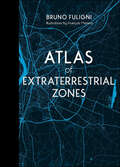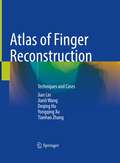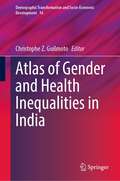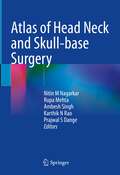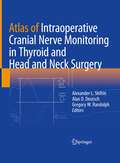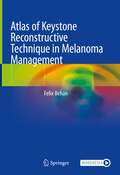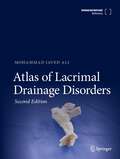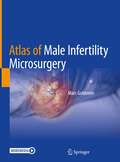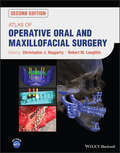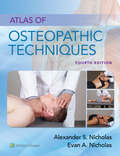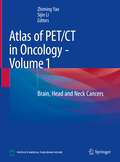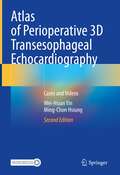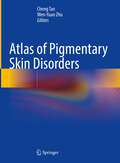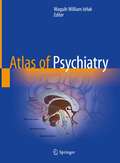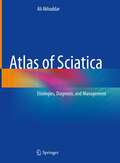- Table View
- List View
Atlas of Assisted Reproductive Technologies
by Surveen GhummanThis atlas provides details of the procedures of assisted reproductive techniques. The science of in-vitro fertilization has made considerable advances and many general gynecologists are now specializing to become infertility experts. It covers embryology and clinical aspects with pictures. This atlas serves as a quick reference as most of the lab work requires pictures of oocytes, embryos and sperms to understand the various stages of the process. It is a comprehensive, updated practical guide on procedures in in-vitro fertilization helpful for general gynecologists and infertility experts.
Atlas of Basic Liver Histology for Practicing Clinicians and Pathologists
by K. S. Mouleeswaran Joy Varghese Mettu Srinivas ReddyThe book provides a visual run-through of liver pathology through high-quality images from the healthy liver through acute liver injury to chronic liver disease - stressing on common mechanisms for specific histological appearances, correlating them with clinical features and laboratory investigations to reach the diagnosis. Individual chapters in this richly illustrated atlas cover the wide gamut of liver disease, including types of liver injury, viral hepatitis, fatty liver disease and its complications, vascular and autoimmune liver diseases, pediatric liver diseases, liver tumors, and finally, pathology of the transplanted liver.This book bridges the gap by integrating basic clinical information with histopathological findings, as existing books cater primarily to the pathologist’s needs and do not provide sufficient clinical background to engage the clinician. It serves as a quick guide for adult and pediatric hepatologists, liver surgery doctors, pathologists as well as trainees in gastroenterology, hepatology, gastrointestinal surgery, liver transplantation and pediatric gastroenterology.
Atlas of Cardiac Surgery (Springer Surgery Atlas Series)
by Francis C. WellsThis atlas provides a comprehensive overview of the current techniques practised in a leading cardiac surgical institution. It offers an up-to-date review of procedures, authored by foremost surgeons in each specialist area. Richly illustrated, its aim is to serve as an appealing “go-to” text for training and practising cardiac surgeons.
Atlas of Chinese Native Orchids
by Xiaohua Jin Jianwu Li Deping YeThis book updates taxonomy information of orchids in China. China is one of the countries with the richest biodiversity. In China, all five subfamilies of Orchidaceae are represented, about 1600 orchid species in 198 genera. All orchids are rare and endangered plants. They are among the flagships for biological conservation, listed in CITES appendix I or II. This book provided an updated classification system of Orchidaceae with newly recorded and published species in China and new combinations. 1026 species in 157 genera of native species in China are included, about half of which are newly recorded or published species in China in the last two decades. Indexes to genera and species are included. For each species, one to four photos, most of which were taken by the authors, are utilized to illustrate habitats, morphological characters, and phenology. Furthermore, the geographic distribution of them also demonstrated in a map. This book can be used as a reference for researchers working on Orchidaceae, as well as practitioners in the horticulture community.
Atlas of Classical History: Revised Edition
by Richard Talbert Lindsay Holman Benet SalwayFeaturing over 130 colour maps of ancient physical and human landscapes spanning Britain to India and deep into the Sahara, this atlas is a compact kaleidoscope of peoples, migrations, empires, strife, cultures, cities and travels from Greece’s Bronze Age to Rome’s fall in the West. This revised edition of the Atlas of Classical History equips readers with a clear visual grasp of the spatial dimension, a vital aspect for understanding history. Users gain insight into the formative roles of physical landscape – seas, rivers, mountains, deserts – in Mediterranean peoples’ development. The maps in all their variety of scope, scale and colour offer an absorbing means to track the growth of states on the ground, especially their relationships, conflicts, urbanization, communications and cultures. Each map is enriched by readily identifiable symbols and concise accompanying texts, as well as recommendations for further reading. With its vast geographical sweep in a compact format, this book is a comprehensive reference work primarily aimed at non-specialists. With updated text and thoroughly revised maps now presented in colour, the Atlas of Classical History remains an essential reference volume for all those interested in the civilizations of ancient Europe, North Africa and Western Asia, as well as for students and scholars of ancient Greek and Roman history.
Atlas of Clinical Cases in Rhinoplasty: Volume I
by Motaz H. ShafyThis atlas discusses a variety of common through to complex clinical presentations in Rhinoplasty. Simple methods of handling different types of noses including large, bulky, crooked, pediatric, deviated and oblique are covered throughout the book. It contains over 2,000 full-colour surgical photographs of both rare and routine cases in Rhinoplasty with all aesthetic challenges examined in detail. The display of the pre- and post-operative photographs is made simple and easy for the eyes to see. Pre-operative photographic assessment, surgical planning and post-operative analysis is included in each case in an easy to follow format so that photographs and texts can be seen and read at a glance. A well-informed, clear guide is written at the beginning of the Atlas.Atlas of Clinical Cases in Rhinoplasty: Volume I is aimed at those who are planning to take Rhinoplasty as a career and experienced surgeons who wish to expand their knowledge and skills. It will be an essential resource for all those seeking a clear, highly visual guide to new developments in Rhinoplasty.
Atlas of Clinical Cases in Rhinoplasty: Volume II
by Motaz H. ShafyThis atlas discusses a variety of common through to complex clinical presentations in Rhinoplasty. Simple methods of handling fractured, finesse, secondary, ethnic and special clinical cases are covered throughout the book. It contains over 2,000 full-colour surgical photographs of both rare and routine cases in Rhinoplasty with all aesthetic challenges examined in detail. The display of the pre- and post-operative photographs is made simple and easy for the eyes to see. Pre-operative photographic assessment, surgical planning and post-operative analysis is included in each case in an easy to follow format so that photographs and texts can be seen and read at a glance. A well-informed, clear guide is written at the beginning of the Atlas. Atlas of Clinical Cases in Rhinoplasty: Volume 2 is aimed at those who are planning to take Rhinoplasty as a career and experienced surgeons who wish to expand their knowledge and skills. It will be an essential resource for all those seeking a clear, highly visual guide to new developments in Rhinoplasty.
Atlas of Clinical Dermatology in Coloured Skin: A Morphological Approach
by Piyush Kumar Pc DasThis Atlas of Dermatology has a unique clinical orientation and lays emphasis on morphology. The disease entities are arranged according to the morphology of lesions, not etiologically. This pattern of placement is more useful for both teaching and learning and serves as an important aid in making a diagnosis as this approach is based on the way patients present themselves in out-patient departments. The key diagnostic clinical pointers too have been provided with images, which helps one suspect the diagnosis and exclude clinical differentials. This Atlas would serve as a ready reckoner for residents and practitioners. Key Features ● An atlas and text covering skin, mucosa, hair and nail diseases in skin of color ● Emphasis on key diagnostic clinical pointers ● 3000+ clinical images--multiple images of a disease to cover the clinical spectrum ● Dedicated section on Regional Dermatology and Skin changes in systemic diseases ● Clinician’s desk reference for OPD practice
Atlas of Dermoscopy: Third Edition
by Ashfaq A Marghoob Ralph Braun Natalia JaimesThe much awaited third edition of the leading reference book in dermoscopy has undergone comprehensive revisions to all chapters, with updates and expanded content providing the reader with a more comprehensive and in-depth coverage of skin conditions, ranging from skin neoplasia to hair, nails, infections and inflammatory diseases. This compilation of contemporary dermoscopy knowledge will benefit the novice in building expertise and benefit experienced practitioners also by providing nuanced insights. Prepare to embark on a journey of learning as leading international experts in the field of dermoscopy explain via text and annotated exemplar images the amazing world of subsurface cutaneous colors and structures visible through a dermatoscope!
Atlas of Extraterrestrial Zones (Atlas Ser. #2)
by Bruno Fuligni32 unusual and fascinating extraterrestrial encounters that explores the places and portals between our world and theirs, with illustrated maps for each location (Book 2 of the bestselling Atlas series) Where is the best place to meet kind and peaceful aliens? How do we communicate with intelligent interstellar life forms, socialize with Martians, and avoid unwanted close encounters of the third kind? These and other answers to ET mysteries are captured in the thirty-two stories in the Atlas of Extraterrestrial Zones, where maps direct readers to the portals that open up between the worlds, a geography of strange events that covers the entire earth, demonstrating how widespread the phenomenon is. Learn about locations of extraterrestrial sightings, hidden bases, secret embassies, and long-lost traces of thousand-year-old passages. From the UFO port of Arès to the underground center of Area 51, from the crash at Roswell to setting up the SETI program, this atlas lists, for the first time, the meeting points between earthlings and these mysterious extraterrestrial biological entities (EBEs).
Atlas of Finger Reconstruction: Techniques and Cases
by Jian Lin Jianli Wang Deqing Hu Yongqing Xu Tianhao ZhangThis book covers latest advancement of finger reconstruction caused by severe injury leading to finger defects, presenting amount of valuable clinical experience and research achievement. This book provides practical guidance for hand and foot surgeons, micro- and reconstructive surgeons, trauma surgeons, orthopedic surgeons, general practitioners as well as trainees.The book mainly contains two parts: Part 1 focuses on development of the history of finger reconstruction, applied anatomy of the extremities, commonly used equipment and materials, frequently used medicines, preoperative treatment, selection of anesthesia, fundamental skill for finger reconstruction, postoperative treatment and management and methods of functional recovery after finger reconstruction. It is not uncommon in clinical scenarios that severe traumas caused by high energy damage in hands leading to life-long disability. The initial injury management is crucial. Surgeons face the arduous task of attempting to repair and reconstruct the injuries, reduce the patient’s disability and improve their quality of life. Part 2 demonstrates the concepts of different types of finger reconstruction with key points described by case presentations. Depending on the types and the severity of the lesions, accuracy of doctor’s judgment and proficiency of surgery skill have vital significance during the treatment of hand trauma together with patients’ compliance on functional rehabilitation.
Atlas of Gender and Health Inequalities in India (Demographic Transformation and Socio-Economic Development #16)
by Christophe Z. GuilmotoHow will the world's largest population approach its inequality challenges? This volume addresses this question by unraveling different strands of India's emerging health and gender geographies. It is the first book to offer a comparative study of these disparities in India, stressing the deep interaction between health challenges and patriarchal features. Most themes explored in this book illustrate the entangled nature of the social and regional determinants of gender and health imbalances in India. Through its rich cartography of contemporary India, the book represents the first Atlas exploiting district-level figures drawn from the latest sociodemographic survey conducted in 2019-21. After an initial methodological synopsis, the book is built around twenty chapters—illustrated by 75 original maps, figures, and tables prepared by thirty authors—and concludes with a synthesis of India's spatial patterns. Chapters engage with major themes of gender and health inequalities and explore an array of innovative indicators such as access to menstrual hygiene, cesarean deliveries, health insurance, son preference in fertility, female landownership, patrilocal systems, hypertension, anemia, hysterectomy, girl-only or single-child families, or traditional contraception. Together, they provide an often surprising glimpse into the present and future of India's gender and health landscape, highlighting the considerable progress accomplished over the last two decades alongside persistent gaps and emerging issues.
Atlas of Head Neck and Skull-base Surgery
by Rupa Mehta Nitin M Nagarkar Ambesh Singh Karthik N Rao Prajwal S DangeHead and neck anatomy is fairly constant, meticulous dissection of the structures and forms the backbone of a successful surgery. The entire diverse spectrum of head neck cancers, thyroid lesions, neural, lymphangiomatous lesions, and carotid body tumors are discussed along with preop, intraop, and postop follow-up pictures. The painstaking selection of intraoperative photographs of various patients operated at our center with an aim to demonstrate the finesse of the surgical management is the motive behind this atlas. The reader picking up this beautifully illustrated volume draws on the surgical expertise of an impressively well-trained surgical team. The atlas will be a pleasure to read and a powerful force to grab the advance treatment standards in the huge variety of head and neck disorders. This atlas will be a valuable resource to aspiring head and neck surgeons and oncologists, and it will act as a volume to refer to in the surgical management of head and neck disorders.
Atlas of Intraoperative Cranial Nerve Monitoring in Thyroid and Head and Neck Surgery
by Gregory W. Randolph Alexander L. Shifrin Alan D. DeutschThis comprehensive atlas is the modern, state-of-the-art guide for intraoperative neurophysiologic monitoring (IONM) and management of the recurrent laryngeal nerve, vagus nerve and other cranial nerves at risk during thyroid, parathyroid and modified radical neck dissection surgery. Based on real-time electrophysiologic images, it will assist the surgeon in the decision-making process by incorporating important information related to the identification of the nerves and their functional status, aiding in the interpretation and improvement of the quality of neural monitoring and reducing inappropriate variations in monitoring technique. Utilization of IONM enables the surgeon to interrogate nerve anatomy and function with immediate quantitative feedback, thereby augmenting surgical training, and importantly, surgical skills and sound anatomic knowledge remain prerequisite and are not supplanted by IONM use. Authored by experts in the field, Atlas of Intraoperative Cranial Nerve Monitoring in Thyroid and Head and Neck Surgery will be the gold-standard text for IONM for endocrine surgeons, otolaryngology surgeons, neurophysiologists, and head and neck surgeons, as well as fellows and residents in these areas.
Atlas of Keystone Reconstructive Technique in Melanoma Management
by Felix BehanWorldwide, it is quoted that 85% of Melanoma cases are treated surgically. The reliability of the Keystone Perforator Island Flap (KPIF) as a reconstructive technique has wide applications. Its low complication rate is the key to its surgical success. The technique is clearly explained in this Atlas by the author, a renowned plastic and reconstructive surgeon, who established this reconstructive principle over 20 years. The illustrations range from simple to complex cases in an easy-to-follow format. Audio files, as a supplementary tool, amplify the technique to enhance the reader’s experience and foster clear understanding. Chapters focussing on anatomical regions contain carefully selected cases accompanied by images to demonstrate a step-by-step surgical technique. The basic design format for all Keystones are highlighted, all sitting within the dermatomal precincts. The KPIF must contain a fascial base for lining and the island outline is an essential pre-requisite. It is hypothesized that this islanding creates a sympathectomy effect resulting in hyperaemic blood flow which optimises healing. Undermining up to 2/3 is permissible as long as there is a deep attachment of 1/3 at the base of the flap to contain the random perforator vascular support. This design allows the rotation, advancement and transposition (ART) of the flap to facilitate the reconstructive closures. Presumably, there are somatic and autonomic neural support lines accompanying the vascular pathways of these random perforator flaps. The vascular perforator tree must not be skeletonised (as in propellor flaps) to allow preservation of such anatomical elements - somatic, autonomic and lymphatic pathways, all of which are an essential component in any surgical repair. This KPIF provides an alternative to microvascular procedures where the biggest drawback is tissue match. The KPIF addresses this problem admirably with a low pain component, an excellent aesthetic match with a low vascular complication rate and a performed in an expeditious manner – these all characterise the KPIF. Simple solutions solve problems and this KPIF Atlas for Melanoma becomes a welcome companion to any surgical speciality including plastic and reconstructive surgeons, surgical oncologists, general surgeons and dermatologists.
Atlas of Lacrimal Drainage Disorders
by Mohammad Javed AliThe second edition of this successful Atlas provides an updated and comprehensive guide to the evaluation and management of lacrimal drainage disorders with 4400+ images.. Lacrimal disorders are one of the most common conditions encountered not only by oculoplastic surgeons and general ophthalmologists, but also by otorhinolaryngologists in their daily practice. It is authored by a world renowned expert in the field. The 2nd edition consists of 103 chapters addressing the basic anatomy and underlying pathology, patient evaluation, and the surgical procedures currently performed in managing various lacrimal disorders. Surgical modalities including the endoscopic approaches are thoroughly and succinctly captured in pictures with detailed legends to aid understanding and offer a visual treat. The book discusses how to deal with surgical complications and failure in detail since familiarity with a surgical technique is incomplete without the knowledge of risk factors and redflags.The 2nd edition of the Atlas of Lacrimal Drainage Disorders is an essential companion to the author’s previous work ‘Principles and Practice of Lacrimal Surgery’.This detailed guide is an indispensable resource for practicing ophthalmologists, oculoplastic surgeons, dacryologists, ophthalmology residents, ophthalmology fellows, practicing otorhinolaryngologists, otolaryngology residents and rhinology fellows.
Atlas of Male Infertility Microsurgery
by Marc GoldsteinInfertility affects approximately 15% of couples attempting to conceive, and male factor is known to be either the primary or a contributing factor in at least half of all cases of couple infertility. More than half of male infertility is amenable to microsurgical treatment, but a majority of urology residency programs provide little or no training in male infertility or its microsurgical treatment. Textbooks typically include a chapter or two on surgery of male infertility, but often these chapters only cover basic concepts and simplified overviews and miss the many finer points that are only taught by observing or scrubbing directly in the operating room. Utilizing Dr. Marc Goldstein's extensive surgical experience, this atlas focuses primarily on microsurgical techniques for restoring and preserving male fertility. The chapters discuss surgical anatomy and diagnosis, microsurgery of the vas deferens and epididymis, varicocele and other fertility-related procedures. Topics and techniques include vasectomy, vasovasostomy, vasoepididymostomy, varicocelectomy, hydrocelectomy, and microsurgically assisted inguinal hernia repair. Equipment, instrumentation and training in microsurgery, including animal models, are also discussed. In each chapter, practical tips and tricks are highlighted. Enhanced by plentiful intraoperative photos and original illustrations, Atlas of Male Infertility Microsurgery is an essential resource for male reproductive surgeons, urologists, residents and fellows.
Atlas of Operative Oral and Maxillofacial Surgery
by Robert M. Laughlin Christopher J. HaggertyATLAS OF OPERATIVE ORAL AND MAXILLOFACIAL SURGERY Comprehensive Learning Resource Covering All Aspects of Oral and Maxillofacial Surgery This textbook marks the second edition of the highly successful Atlas of Operative Oral and Maxillofacial Surgery. The first edition quicky became a staple with surgeons on rounds, in training programs and in preparation for board examinations. This atlas is comprised of concise text and detailed vignettes focusing on surgical indications, contraindications, pertinent anatomy, virtual surgical planning, operative techniques, postoperative management, complications and key points with over 2,000 high-quality images. The Atlas of Operative Oral and Maxillofacial Surgery serves as an innovative, multidisciplinary, surgical atlas covering core aspects of oral and maxillofacial surgery, head and neck reconstructive surgery, and facial cosmetic surgery. Chapters are written by experts in their fields and are designed to provide high-yield information utilizing a case report format. New to this second edition: Contemporary coverage of dental implants, including digital implant planning, grafting techniques, implant supported restorations of the edentulous arch, immediate implant placement and provisionalization. Management of facial infections including odontogenic head and neck infections, osteomyelitis and medication related osteonecrosis of the jaws (MRONJ). Recent advances in facial trauma surgery, orthognathic surgery and facial reconstructive surgery utilizing virtual surgical planning, custom plate fabrication and the latest surgical techniques with case reports. Expansion of the orthognathic and craniofacial section to include new case reports and chapters on orthognathic surgery in cleft patients, cranial vault surgery and the evaluation and planning of concomitant TMJ and orthognathic surgeries. Advances in the field of facial cosmetic surgery including cryolipolysis, fat transfer, soft tissue fillers and the latest technique updates. Elaboration of the facial ablative and reconstructive surgery sections to include virtual surgical planning, custom plate fabrication, osteotomy cuts guides and the latest hard and soft tissue harvest techniques.
Atlas of Osteopathic Techniques
by Alexander S. Nicholas Evan A. NicholasEasy to navigate and rich with engaging learning features, the 4th edition of this bestselling, one-of-a-kind resource reflects the most up-to-date information on basic anatomical concepts and techniques to help users confidently comprehend and apply them.
Atlas of PET/CT in Oncology - Volume 1: Brain, Head and Neck Cancers
by Zhiming Yao Sijin LiThe atlas aims to help practitioners to interpret PET/CT images of tumors in brain, head and neck in a timely and accurate way. Illustrating in a case-based manner, the PET/CT appearances of glioma, meningioma, nasopharyngeal carcinoma, eye tumors, ear and temporal bone tumors, and neck tumors are covered. Each chapter is organized in the same format of clinical overview, PET/CT diagnosis, typical/atypical/confusing manifestation of the diseases. This book will be a useful reference to residents and practitioners in nuclear medicine, radiology, oncology, radiation oncology and nuclear medicine technology.
Atlas of Perioperative 3D Transesophageal Echocardiography: Cases and Videos
by Wei-Hsian Yin Ming-Chon HsiungThis book presents a series of over 50 cases in 3D transesophageal echocardiography. In each case, background information is followed by a step-by-step approach to patient diagnosis and postoperative outcomes. The book’s most outstanding highlight consists in over 600 illustrations, which mainly focus on 3D transesophageal echocardiography in combination with 2D transesophageal echocardiography, X-ray fluoroscopy and computed tomography to demonstrate the various cardiovascular pathologies. Since the echo images obtained in clinic practice are moving images, it also includes more than 450 videos, which effectively supplement the static illustrations. The atlas is divided into 11 chapters. Chapters 1 through 3 describe abnormalities affecting mitral, aortic, tricuspid and pulmonary valves, while prosthetic valves are discussed in Chapter 4. Chapter 5 details abnormalities of the aorta. Chapters 6-8 examine coronary artery disease, congenital heart disease and cardiomyopathies, while Chapter 9 explores cases of infective endocarditis. Chapter 10 deals with tumor and mass lesions, and the other cases are collectively addressed in Chapter 11. In this second edition, authors add 3-5 new cases at each chapter. Now new technology in 3D TEE rendering technology such as TruVue, a kind of post processing techniques, is also included. Offering a valuable new resource, the book will enhance the usefulness of echocardiography during operations as a “third eye” for surgeons. With the advances in technology, clinicians are using three‐dimensional (3D) transoesophageal echocardiographic imaging is crucial for device selection during the procedure and to assess the functional result after procedure.
Atlas of Pigmentary Skin Disorders
by Wen-Yuan Zhu Cheng TanThis atlas is written to provide readers with the clinical and pathological presentation of the broad spectrum of pigmentary skin disorders (PSD). This book is divided into six parts and covers diseases of hypopigmentation, disorders of hyperpigmentation, hyperpigmentation coexisting with hypopigmentation, pigmentary disorders of the hair, nails, and mucous membranes, and neoplasms with dyschromatosis encountered in clinical practice. Written by experts with rich experience in the field, it will be an invaluable reference not only for dermatologists, cosmetologists, and geneticists but also for anyone interested in the exciting area of PSDs.
Atlas of Psychiatry
by Waguih William IsHakThis atlas is the first fully visual reference to cover psychiatry broadly, appealing to psychiatric as well as non-psychiatric clinicians and trainees who need an easy-to-use visual resource with holistic approach to patient care. Written by expert clinicians and educators, this text describes basic clinical and scholarly information across the field utilizing an easy-to-understand format. The rich figures and tables describe etiology, pathophysiology, phenomenology, and treatment even in areas that are difficult to illustrate, including substance-related disorders, neurodegenerative diseases, personality disorders, and others. The visual approach proves valuable to some of the most innovative techniques in psychiatry, including implications for neuroimaging. Comprehensive and unique, Atlas of Psychiatry is a landmark reference for all medical practitioners looking for an intricate yet accessible visual resource.
Atlas of Sciatica: Etiologies, Diagnosis, and Management
by Ali AkhaddarThis atlas is the first reference covering exclusively all aspects of sciatic pain. It is designed to serve as a brief and easy-to-comprehend review of the knowledge of spinal sciatica, with emphasis on classification, epidemiology, clinical presentations, neuroimaging, and treatment options. Sections on extraspinal sciatica and differential diagnosis of this multifaceted topic are also included. This atlas delivers more information in less space than traditional texts, allowing for a quick review of the essential facts of this clinical entity through plentiful images and tables. Pertinent imaging is combined with intraoperative photographs and hand-drawn illustrations to help readers visualize variable presentations and enhance their management. The comprehensive content of this richly-illustrated book covers different etiologies of sciatic pain seen in spinal, neurosurgical, neurologic, rheumatologic and emergency practices, divided into five thematic sections. After general considerations about sciatica and their differential diagnosis, the second section focuses on lumbosacral discogenic sciatica. The third section includes spinal non-discogenic sciatica. The fourth section focuses on extraspinal intrapelvic sciatica, and the fifth provides a description of the most important etiologies of extraspinal extrapelvic sciatica. Comprehensive and unique, Atlas of Sciatica is an excellent pictorial resource for neurosurgeons, spinal surgeons, neurologists, rheumatologists, and many other clinicians worldwide. It is a “one of a kind” book that stands head and shoulders above any other book on this subject (from the foreword of Professor Edward C. Benzel, MD, Founder of the World Spinal Column Society).
Atlas of Sinonasal Tract Pathology
by Deepali Jain Justin A. BishopThis book reviews normal anatomy and immunohistochemical profile of sinonasal tract (SNT) and covers histomorphology of infections some of which are unique to Asia, tumor-like lesions, and rapidly evolving spectrum of benign and malignant tumors of SNT. It describes all the entities with the help of over 200 full color photomicrographs with their detailed descriptions. The book includes relevant clinical and radiology photographs and anatomical drawings complemented by short bulleted legends describing the picture and providing relevant information. In addition to surgical pathology, it includes a chapter on the cytology of SNT lesions, which is described rarely in available books and literature. It serves as a concise and informative resource for easy understanding. The book is written by leading experts in pathology around the world from USA, Europe and Asia. It highlights the expanded role of pathologists in patient care of SNT lesions. This book is suitable for clinicians, practicing pathologists, faculty, pathology residents and students. This will help the post-graduate students in pathology to understand this area in detail and to be able to answer questions on SNT resection/biopsy cases asked in their board exams of residency.

